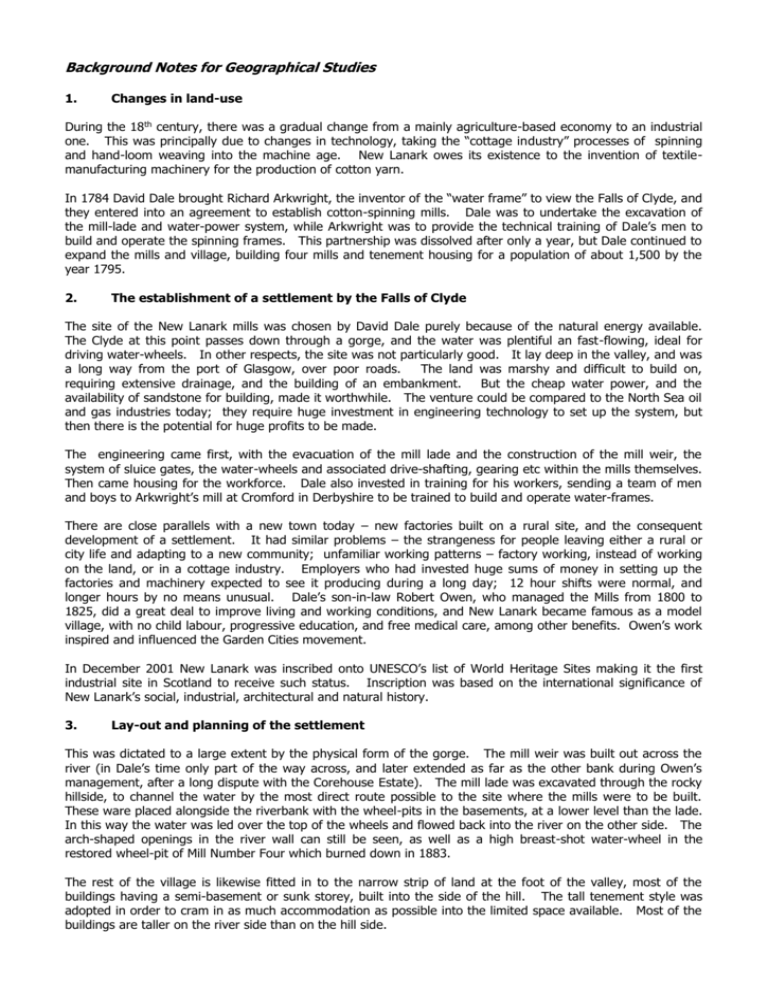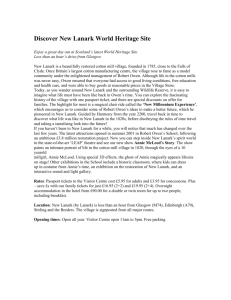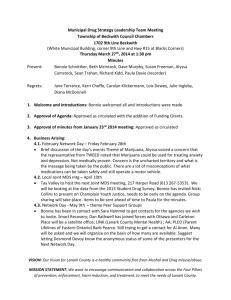8. Background Notes for Geographical Studies
advertisement

Background Notes for Geographical Studies 1. Changes in land-use During the 18th century, there was a gradual change from a mainly agriculture-based economy to an industrial one. This was principally due to changes in technology, taking the “cottage industry” processes of spinning and hand-loom weaving into the machine age. New Lanark owes its existence to the invention of textilemanufacturing machinery for the production of cotton yarn. In 1784 David Dale brought Richard Arkwright, the inventor of the “water frame” to view the Falls of Clyde, and they entered into an agreement to establish cotton-spinning mills. Dale was to undertake the excavation of the mill-lade and water-power system, while Arkwright was to provide the technical training of Dale’s men to build and operate the spinning frames. This partnership was dissolved after only a year, but Dale continued to expand the mills and village, building four mills and tenement housing for a population of about 1,500 by the year 1795. 2. The establishment of a settlement by the Falls of Clyde The site of the New Lanark mills was chosen by David Dale purely because of the natural energy available. The Clyde at this point passes down through a gorge, and the water was plentiful an fast-flowing, ideal for driving water-wheels. In other respects, the site was not particularly good. It lay deep in the valley, and was a long way from the port of Glasgow, over poor roads. The land was marshy and difficult to build on, requiring extensive drainage, and the building of an embankment. But the cheap water power, and the availability of sandstone for building, made it worthwhile. The venture could be compared to the North Sea oil and gas industries today; they require huge investment in engineering technology to set up the system, but then there is the potential for huge profits to be made. The engineering came first, with the evacuation of the mill lade and the construction of the mill weir, the system of sluice gates, the water-wheels and associated drive-shafting, gearing etc within the mills themselves. Then came housing for the workforce. Dale also invested in training for his workers, sending a team of men and boys to Arkwright’s mill at Cromford in Derbyshire to be trained to build and operate water-frames. There are close parallels with a new town today – new factories built on a rural site, and the consequent development of a settlement. It had similar problems – the strangeness for people leaving either a rural or city life and adapting to a new community; unfamiliar working patterns – factory working, instead of working on the land, or in a cottage industry. Employers who had invested huge sums of money in setting up the factories and machinery expected to see it producing during a long day; 12 hour shifts were normal, and longer hours by no means unusual. Dale’s son-in-law Robert Owen, who managed the Mills from 1800 to 1825, did a great deal to improve living and working conditions, and New Lanark became famous as a model village, with no child labour, progressive education, and free medical care, among other benefits. Owen’s work inspired and influenced the Garden Cities movement. In December 2001 New Lanark was inscribed onto UNESCO’s list of World Heritage Sites making it the first industrial site in Scotland to receive such status. Inscription was based on the international significance of New Lanark’s social, industrial, architectural and natural history. 3. Lay-out and planning of the settlement This was dictated to a large extent by the physical form of the gorge. The mill weir was built out across the river (in Dale’s time only part of the way across, and later extended as far as the other bank during Owen’s management, after a long dispute with the Corehouse Estate). The mill lade was excavated through the rocky hillside, to channel the water by the most direct route possible to the site where the mills were to be built. These ware placed alongside the riverbank with the wheel-pits in the basements, at a lower level than the lade. In this way the water was led over the top of the wheels and flowed back into the river on the other side. The arch-shaped openings in the river wall can still be seen, as well as a high breast-shot water-wheel in the restored wheel-pit of Mill Number Four which burned down in 1883. The rest of the village is likewise fitted in to the narrow strip of land at the foot of the valley, most of the buildings having a semi-basement or sunk storey, built into the side of the hill. The tall tenement style was adopted in order to cram in as much accommodation as possible into the limited space available. Most of the buildings are taller on the river side than on the hill side. Because it was built as a deliberately planned settlement, rather than developing in a random way as country villages normally did, with houses clustering round a church or market-place, the village of New Lanark is very linear in plan, following the line of the river and the contour of the hillside. 4. Development of Water-power The water-power was developed at first by water-wheels, but as technology improved, water-turbines replaced the old wheels which were powerful enough to drive a generator and produce hydro-electricity. In the 1920’s a company was formed to generate hydro-electricity using the Corra Linn waterfall. Known as the Bonnington Power Station, it was completed in 1926. This required an Act of Parliament to allow the water to be diverted from the river, and the Gourock Ropework Company which owned the New Lanark Mills at that time, objected strenuously, fearing that the development upstream from the mills would affect their own supply of power. In fact, however, the diverted water flows back into the river at the power-station, and the operation only rarely affects the supply down at the mills, if the Bonnington Weir is closed for a short time. The mills at New Lanark continued in production until 1968, much later than most cotton-mills, and the cheap energy was a major factor in this. During the 1990s, the mill-lade, sluice gates and a 1930s water turbine were restored, and once again environmentally friendly hydro-electricity is being generated on site. This is fed into Scottish Power’s grid, and the Conservation Trust receives payment for the electricity produced. The system is now controlled by a sophisticated computer system. Please see the NLCT booklet, “The New Lanark Power Trail” for more detailed information and map of the water-power systems. 5. Changes in the pattern of population During the 18th century, the industrialisation of the central belt between the main ports at Glasgow on the West coast and Leith on the East, began to take place, and with it a huge growth in the population of these areas at the expense of the Highlands and Islands, and the Borders. The story of the shipwrecked Highlanders and Dale subsequently advertising for workers throughout the Highlands and Islands exemplifies perfectly this pattern of population drift and how it came about. ( Please see the NLCT booklet “ The Story of the New Lanark Highlanders” for more details). The North and west of Scotland had a long established history of emigration overseas, which Dale and his contemporaries were anxious to halt, seeing the creation of jobs and industrial settlements like New Lanark as a possible solution to the problem. This tendency to emigrate was, however, accelerated by the Clearances in the early 19 th century. Irish families were also attracted to New Lanark especially in the early years of the 20th century, when the Gourock Ropework Company took over. (Please see section on Irish Immigration, in “Investigating New Lanark” 1880-1990). 6. Relationship to ports and railway systems Like many other “factories in the country”, New Lanark was a long way from the ports where its raw material was landed. Bales of raw cotton were shipped across the Atlantic from the Southern States of America and the West Indies, and docked at Greenock or Port Glasgow, and Liverpool. The only form of transport available was by horse-drawn wagon, until the 1850s when a branch-line of the Caledonian Railway finally came to Lanark. Even then, there was never a line linking New Lanark, and the bales of cotton as well as the finished products continued to be transported by horse and cart between the mills and the railway station, until this system was suspended by the advent of a steam-driven lorry. Later still road haulage was preferred, and the cotton came by road from Liverpool in 20 ton loads. (Please see section on Transport in “Investigating New Lanark” 1880-1990). 7. Post-industrial developments, impact on employment and population Following the closure of the mills in 1968, the future for New Lanark looked bleak. The 350 people who were still employed at the mills were out of work, and the population of the village dwindled. (Please see NLCT information sheets on Population Statistics, Restoration and Revitalisation). Refurbishment of the housing had begun, but faltered as there seemed no point in restoring the housing in a village where there were no jobs. However, as a result of the report of a Working Party set up to consider the future of New Lanark, the New Lanark Conservation Trust was founded in 1974 with the seemingly impossible task of restoring and revitalising the village. By the 1990s however, the population had risen again to around 180, the restoration programme was well on its way to completion, New Lanark was a nominated World Heritage Site, and firmly established as one of the country’s most popular rural visitor attractions. Over the course of the restoration programme, hundreds of people were employed on the building work, and by 1996 around 150 people were employed in permanent jobs in the village, and approximately 50 more created when the Mill Hotel opened in 1998. 8. Change of use of buildings, development of tourism and leisure facilities New Lanark Conservation Trust was founded in 1974 with the task of restoring and revitalising the historic mill village. There are four main strands to the conservation project in New Lanark: housing, tourism and leisure, commercial tenancies, and hydro-electricity generation. Housing (carried out through the Trust’s sister organisation New Lanark Association Ltd, a registered housing association founded in 1963) does not involve a change of use of the buildings, except in one or two cases, e.g. David Dale’s House (now let as a commercial tenancy to an independent publishing company) or “Wee Row” (now converted from tenement housing to a 62 bed Youth Hostel). The development of tourism and leisure facilities is extremely important in the revitalisation of the village itself, but also in the regeneration of the wider economy of post-industrial Lanarkshire. As the New Lanark Conservation Trust is an independent registered charity, not a national museum, it has to stand on its own feet financially, and the revenue that can be earned from visitors is vitally important. Therefore it was seen as a top priority to establish a popular Visitor Centre with exhibitions, catering, gift shops etc, to encourage people to come. The former mill buildings, the Dyeworks, the Village Store and the Institute for the Formation of Character (Robert Owen’s community education centre) were adapted for these purposes. The village’s special history lends itself to the creation of a Visitor Centre with many different strands, and the natural beauty of the site with the adjacent Falls of Clyde Wildlife Reserve is another positive selling-point. Nor is it anything new for the village to attract visitors: the Falls and the village of New Lanark have been a source of interest to tourists for well over 200 years. In 1991, the New Lanark Visitor Centre was awarded the British Tourist Authority’s “Come to Britain” trophy, a major achievement in the face of national competition. By 1996 around 400,000 people were visiting the village annually and making use of the visitor centre facilities. (Please see NLCT information sheet on Visitor Figures). Visitors come from all over the world, especially in the summer months. However, the largest single group of visitors comes, as you would expect, from the Central Belt of Scotland, New Lanark having become a popular destination for day-trippers. Organised educational visits also form a significant part of our paying visitors - around 25% in 2001. In 1998, the New Lanark Mill Hotel opened in the recently restored Mill One and adjoining Waterhouses. This is a 38 bedroom hotel with restaurant, conference and banqueting facilities, and 8 self-catering apartments. Future plans for the hotel include the development of additional conference facilities and a leisure suite with swimming pool. The most recent development in the Visitor Centre has been the restoring of Owen’s School for Children which opened to the public in 2001 with new exhibitions and facilities for visiting school groups. Apart from revenue gained from tourism, the renting out of other industrial buildings for office, retail or workshop space, is also very important. This gives the Conservation Trust all year round revenue, not dependent on the state of the tourist trade, and the means therefore to keep the buildings in a good state of repair. Bringing commercial operations into the village also improves local employment prospects. By the mid 1990s New Lanark was once again one of the largest employers in the Lanark area. (see NLCT information sheet on New Businesses and Employment in New Lanark in the 1990s). In 1997, New Lanark won a Best Practice award from the British Urban Regeneration Association. In the 1990s, the original water power systems dating back to the 1780s were overhauled, and a 1930’s water turbine restored. New generating plant was installed, and a computer controlled-system introduced. The hydro-electricity generated is fed into Scottish Power’s grid, and the pay the Conservation Trust for it. This makes a contribution to site revenue, and also complies with the Trust’s policy of achieving revitalisation through developments which are environmentally sensitive. File ref: 5a.18.1 Background notes for geographical studies - Update January 2002





